Peter Anthony Burnell-Phillips, DFM
Peter Anthony Burnell-Phillips, 1916-41
Peter was born in Richmond, Surrey, on the 5th May 1916. His parents were Anthony and Ida Burnell-Phillips and he is recorded as having been educated at St George's College, Weybridge. However, at the time of initial investigation, back in 1992, the official Old Boys record keeper then, the Rev. A. F. Owen, could find no written record of his having attended this particular school. Peter was a very sporty person who loved speed and won several trophies for boxing and motorcycle racing.
His parents were involved in the world of theatre in the West End of London but he appears to have been largely raised by the Lloyd family of Redhill, Surrey. He may well have been orphaned, as Angus Robson, a descendent of the Lloyd family, wrote that: " …he was effectively adopted by my Great Grandmother in Redhill, whose family were devout churchgoers and vicars. The family seemed to take in or adopt many orphaned children for various periods - Tony [the family name for Peter BP] was one of the children that the family adopted." (1) He was described in Lloyd family circles, as someone who was a 'bit of a tearaway'.
1. Letter from Angus Robson, 2017.
Joins RAF
He first joined the RAF on a short-service commission in February 1936 and, after training at Cranwell, joined 54 Squadron at Hornchurch before moving to 65 Squadron, flying Gloster Gladiators. Unfortunately for his future prospects, he got himself into hot water when, spurred on by a bet, he flew at roof-top height along the High Street at Crowborough, in Sussex. Since this was decidedly frowned upon by his superior officers, Peter was forced to resign his commission.
This was a desperate blow for Peter, a man who loved flying, and, knowing what he had carelessly thrown away, he joined the RAFVR in the ranks only weeks later on 30th April, 1937. He was called up for full-time duties in October, 1939, and posted to 607 (County of Durham) Squadron in July 1940 as a Sergeant Pilot.

607 Squadron insignia
While Peter was a member of this squadron he moved 'home' frequently, as was the case with most squadrons during the perilous years of 1940-41. Often, a posting to Scotland was to allow for rest and recuperation from the stress and losses during the battle in the southern counties of England. Between 4th June 1940 and 16th April 1941, (i.e. after Peter's death in February), 607 was posted to:
RAF Usworth, Co. Durham from 4th June to 1st September 1940
RAF Tangmere, West Sussex, from 1st September to 10th October 1940
RAF Turnhouse, City of Edinburgh, from 10th October to 8th November 1940
RAF Drem, East Lothian, from 8th November to 12th December 1940
RAF Usworth, Co. Durham, from 12th December 1940 to 16th January 1941
RAF Macmerry, East Lothian, from 16th January to 2nd March 1941
RAF Drem, East Lothian, from 2nd March to 16th April 1941
607 Squadron was sent to France during the German invasion and was re-equipped with Hurricanes. Peter's time with 607 coincided with the Battle of Britain and he had considerable success during it. While flying from Usworth he claimed two Heinkel He IIIs, which had flown, without fighter escort due to the distances involved, when they attacked the Newcastle/Sunderland area during August. The Squadron then transferred to one of the 'hottest' areas of the Battle of Britain, to RAF Tangmere, just two weeks after it had been seriously damaged by a Luftwaffe attack. Burnell-Phillips continued his run of success and downed a Dornier 17 on the 9th September. On this sortie, in Hurricane P2912, his engine failed and he force landed at Knockholt, Kent. He was wounded with a bullet in one of his ankles.
On the 26th September, having run out of ammunition, he forced a Dornier 17 to crash into the sea by repeatedly making mock attacks. On 30th September he claimed to have destroyed a Messerschmitt Bf110 and he shared a victory over another Heinkel He 111 on 4th October. On the first of November he was awarded the DFM, being credited with at least five victories. Five victories earns the accolade of 'ace'.
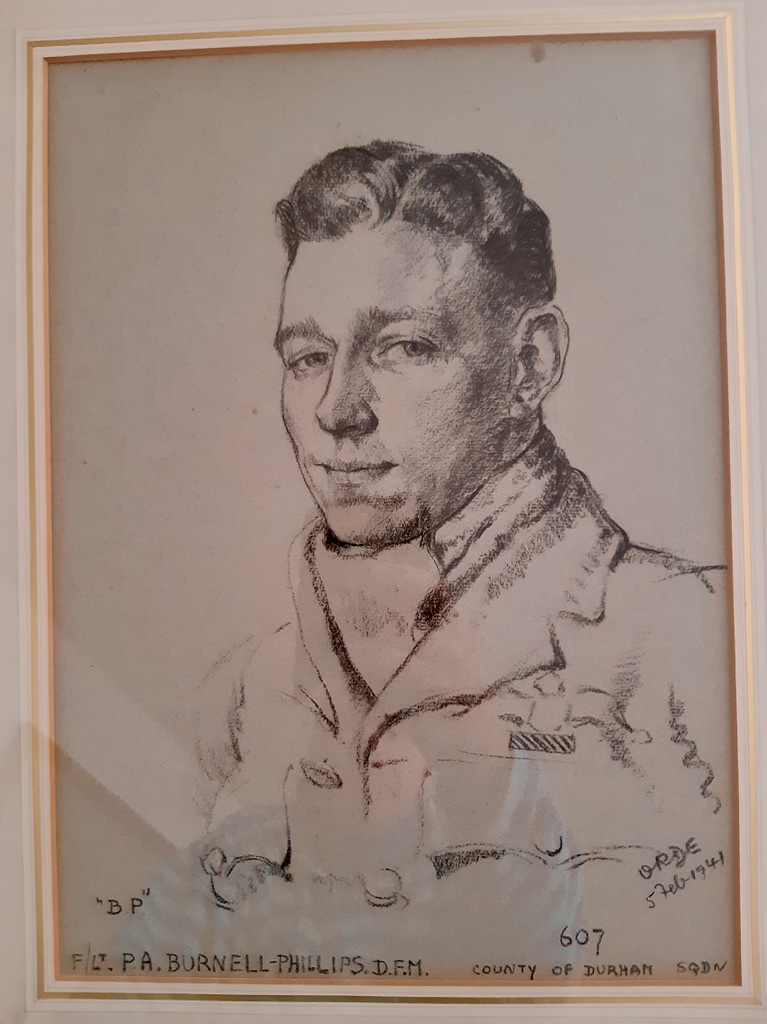
This portrait of Peter Burnell-Phillips was drawn by the famous wartime artist Cuthbert Orde just five days before Burnell-Phillips crashed on the edge of Haddington.
Courtesy of Angus Robson and John Hamilton of "Lost Haddington".
Angus Robson, wrote this description of the background of the artist and of the portrait which he presently owns:
"Orde was an artist who was commissioned by the Air Ministry to draw portraits of many of the top Battle of Britain pilots. Orde toured the RAF bases and sketched a handful of pilots who were typically nominated by their Squadron Leader. Tony's portrait is dated 5 February, 1941. Orde has been occasionally quoted about the impressions that the pilots he sketched made on him, and apparently his comment about Tony was that he was 'inherently tough'. I imagine the portrait must have been sketched at RAF Macmerry where 607 Squadron was based in early 1941 - tragically Tony's fatal accident happened a mere four days after the portrait was dated."
9th February 1941
On this date, Peter was indeed stationed at RAF Macmerry. After taking off with two other Hurricanes, he entered cloud and must have lost his bearings. He over-corrected and induced a high speed stall which he tried to correct but had insufficient height to do so, and belly landed hard in a field just to the north of Haldane Avenue, Haddington, East Lothian. He was killed immediately and the Hurricane he was flying, W9189, was burnt out in the crash. He was twenty-four years old.

The burnt out wreck of Hurricane, W9189 ©

Looking west
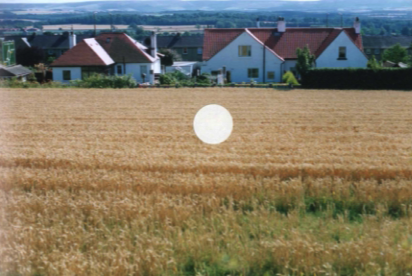
Looking south
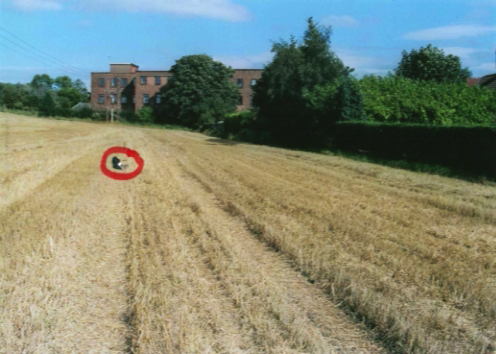
Looking east - the red building is the former hospital, the Vert, and is mentioned in George Angus's account below. It is now in flats.
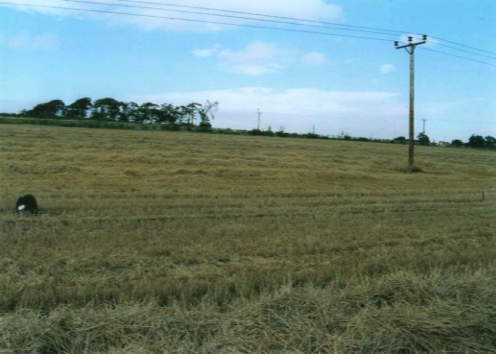
Looking north - the bag marks the spot
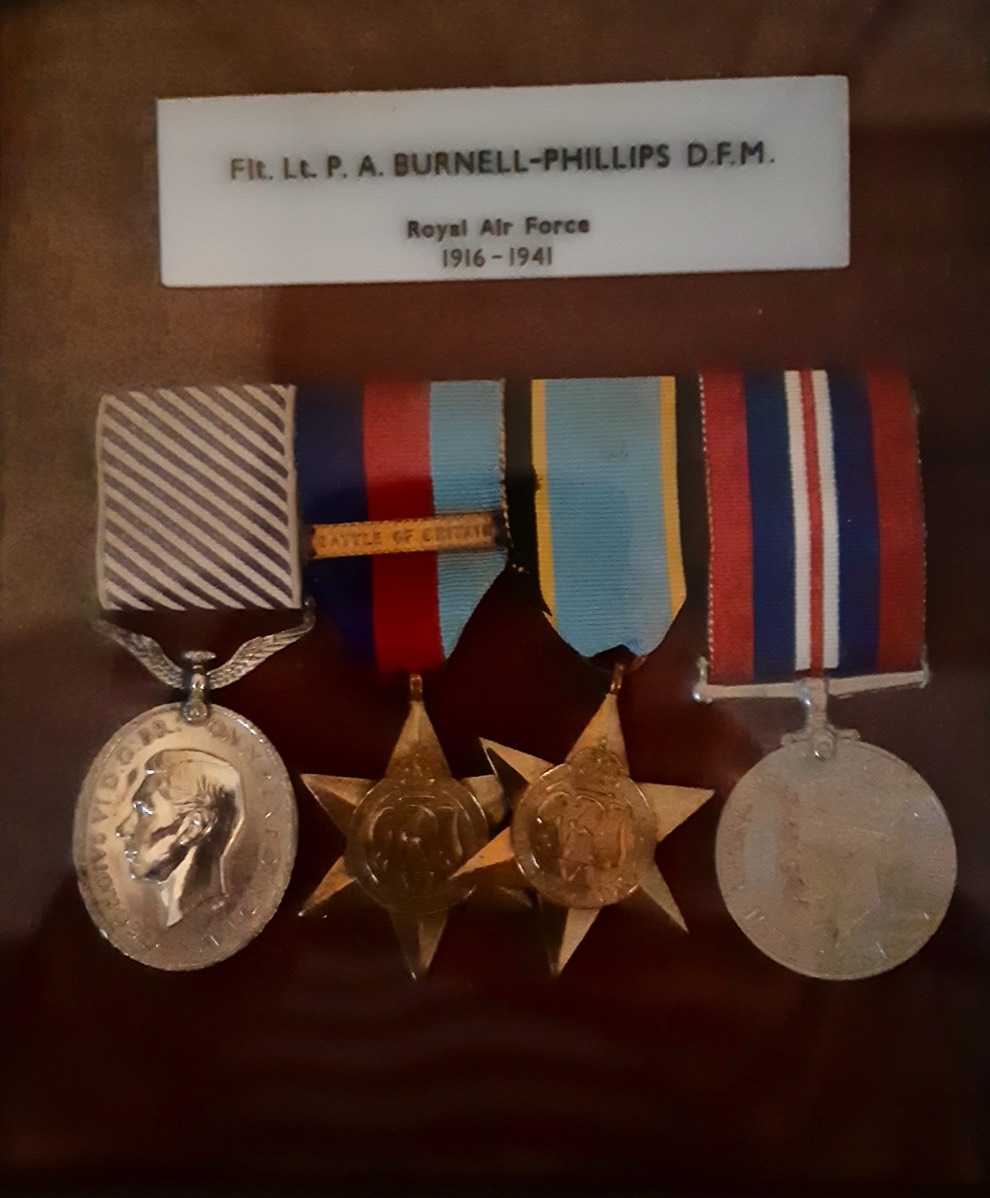
Burnell-Phillips's medals, including the DFM on the left.
Photo courtesy of Angus Robson and John Hamilton of "Lost Haddington".

Pilot Officer Peter Anthony Burnell-Phillips is buried in Dirleton New Cemetery, in plot 998 Section E. The small cemetery lies to the right of the B1345, just before it meets the A198 from Gullane to North Berwick.
Marked on the stone is
'In thy presence is fullness of joy'. Psalms XVI.11
We have two eye-witness accounts of the crash.
Mrs Jean Cummings wrote:
"We were a family of four young girls playing in the front garden of 9 Haldane Avenue on the Sunday of 9th February, 1941, when, all of a sudden, there was a droning noise. We remember our mother shouting to come in quickly and saying a plane was coming down and when we all looked up it was spiralling downwards. I can remember we were all put under the dining-room table and there was this enormous bang.
My sister Janet still maintains it just missed our back garden and it was in the field behind our house but slightly to the right. She said Mr Nisbet and Mr Leslie ran with rakes, etc., to help the pilot out but the plane burst into flames and they had to withdraw. She said the plane on impact was not badly broken up but she was sure the pilot would [have] been killed instantly. Bullets were flying everywhere and we had to take cover.
That morning there had been planes flying around and we were very used to this but from the time of the crash the skies became quiet and empty, the planes had disappeared back to their base.
Police were the first to arrive and they kept sightseers back and eventually the army arrived. Why the army, I don't know but they put guards on the plane, etc., and checked gardens and the field for debris. They made Gardiner's garage at 5 Haldane Avenue their cookhouse where the soldiers got all their meals but asked for volunteers to billet the soldiers. Janet says that I duly said my mother would take two and that's how we got two soldiers staying and bringing some extra rations which was great. We think they stayed for two or three nights but I'm really not sure. Eventually the plane was taken away on a lorry.
…I and my grand-daughter Victoria have visited Flt. Lt. P.A. Burnell-Phillips grave and laid flowers and poppies on Remembrance Sunday."
"I was fifteen at the time and lived with my parents at Alderston Lodge, which lies just 540 yards W-S-W of the point of impact.
About mid-afternoon on Sunday 9th February 1941, I went out of the house to fetch a shovel of coal from our coal cellar, when I heard the sound of Merlins overhead, rising and falling, and when I looked up I could see three Hurricanes engaged in mock dogfight in and out of the clouds, the base of which was about 6,000 feet. Being 'dead-keen on the RAF', I stood for at least a minute, with neck craned and empty shovel by my side, to watch the show.
Suddenly one of the Hurricanes went into a spin, less than 1/4 of a mile to the east of me, and I watched it gyrating down. About half way down the engine cut, or it may have been throttled back. A little later the pilot obviously took corrective action, because the engine stopped and I found myself looking at the upper surface of the wings as it dived apparently directly at the Cottage Hospital [the Vert] which lay another 150 yards further east. It was in use at the time.
The pilot then took steps to pull out of the dive in my direction, but he was a fraction of a second too late. The Hurricane seemed to flatten out, missing the North side of the hospital by yards, but he was unable to prevent it striking the ground at a shallow angle in an open field just north of the gardens of the houses in Haldane Avenue. The aircraft bounced and when it struck a second time the fuel tanks exploded and all disappeared in a fireball.
I was able to see all this, although there was a wood of sorts a short distance from our house, because there were no leaves on the trees. At the time I estimated that it happened behind No. 6 Haldane Avenue, but when I walked along later to visit the site, I seem to recall a pair of two storey semis in the background, which would be Ns 4 & 5. Anyway, the wreckage was still smoking, but it was so badly broken up that it was now impossible to identify it as a Hurricane.
I estimate the map reference of the accident spot to be NT 50597443."
We also have evidence, given in a personal letter dated 12 January 2002, written by a member of the RAF Medical Services at Drem who attended the crash site. Unfortunately his full name is unknown but the letter is signed, Jack, U., perhaps V. He wrote that:
"…this was the second 607 crash in very few days I had attended. Lo and behold, I am in the snap [the photo of wrecked Hurricane shown above] just having covered the pilot with a brown blanket [and] about to lift his body to take back to our ambulance…he was very nearly clear of the craft although no sign of trapped legs and not strapped inside the cockpit!!
When I returned to Drem I had a right rollicking from the Sgt i/c SSQ [Station Sick Quarters], as I just grabbed the Driver and flew out of SSQ. I had the opposite, praise, from SMO S/L [Senior Medical Officer, Squadron Leader] Adam Muir, when I met him just going back to the crash.
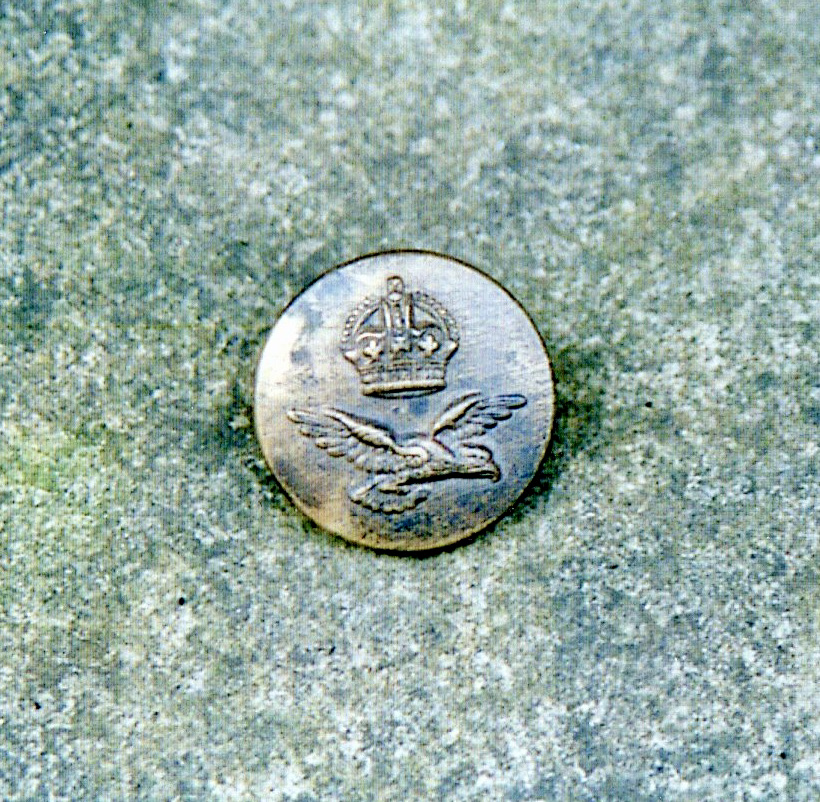
RAF tunic button found at the crash site.

